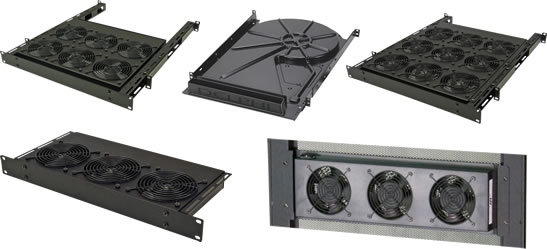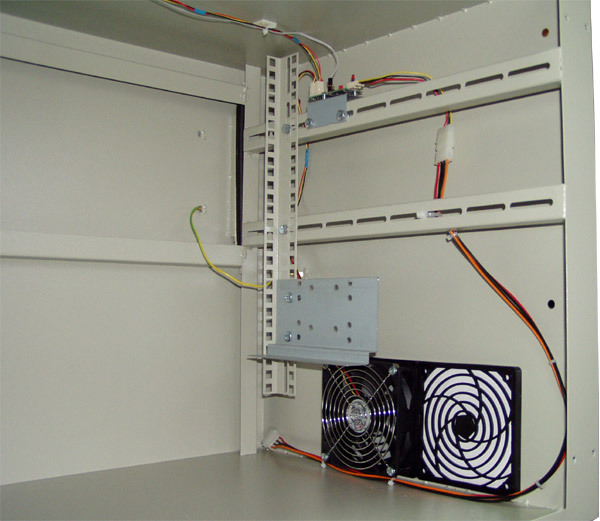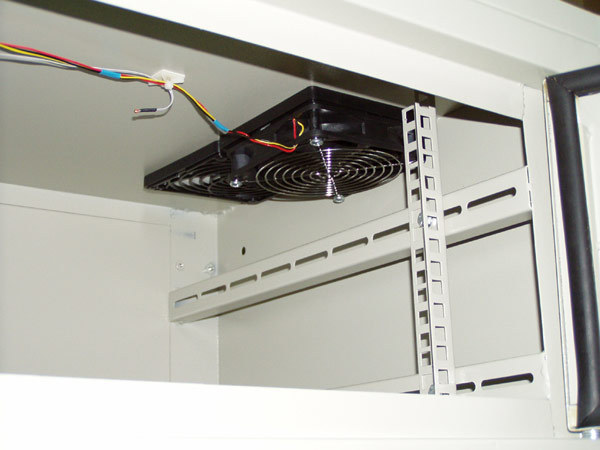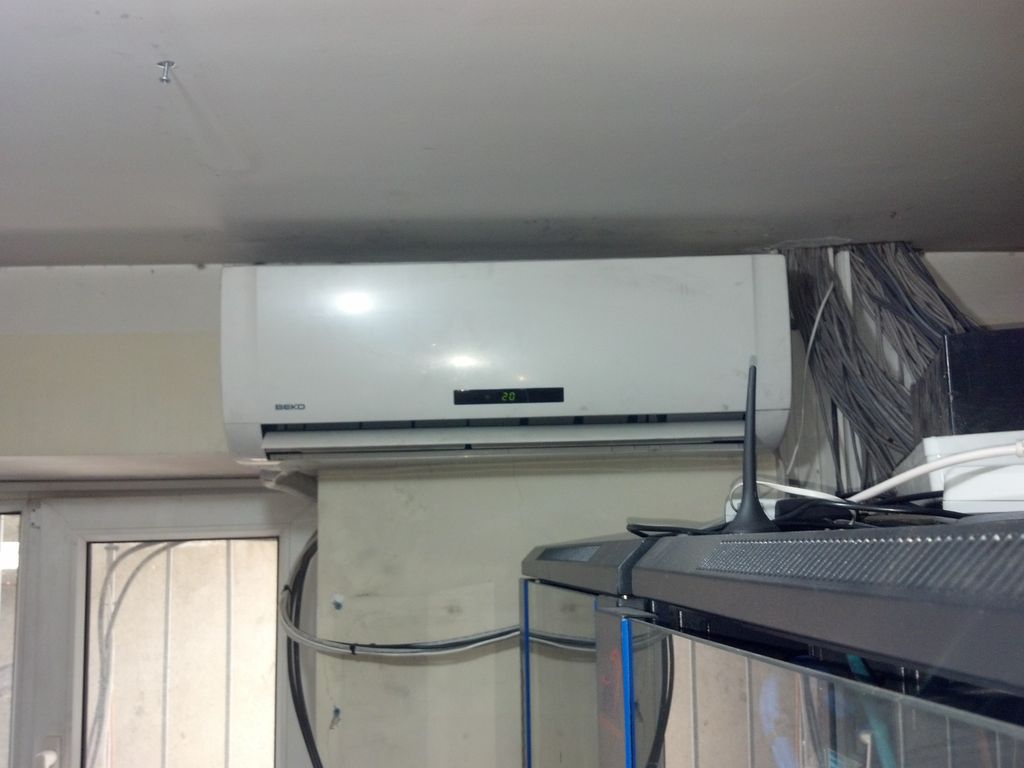Why is it important to maintain temperature in the server. As usual cooling server
Perhaps from the very beginning I would like to figure out what a regular server room can be. As a rule, this is an enclosed space, often of small size, sufficient to accommodate server racks with a specific set of network equipment. In most cases, the server room is located either in the basement / basement or in the attic. That is, the leadership of the organization does not think about the location of the server room in the first place.
Suppose the server room is in a basement or semi-basement room. In this case, the air conditioning of the room will be sufficient to carry out the usual conditioner (split-system) on the market. However, it should be borne in mind that the proximity of the soil and the location of the premises below the level of the soil will also be felt. The factor of the presence of excess moisture is not excluded. Also, it is possible that there are heating communications, water supply in the server room or in the immediate vicinity, which will also have a direct impact on the temperature regime. Suppose that the choice of location for the server room was carried out at the very last turn, and it turned out that a heating radiator was installed in the room, or there were communications with hot water. This circumstance will undoubtedly additionally load the cooling system and will add certain risks of equipment failure in case of a cooling system failure. But do not forget that in some cases it requires the installation of an additional heating system to maintain the temperature. This requires a controlled heater. The cooling system and the heating system must be controlled by a unified device,
which would allow to read data from temperature and humidity sensors and transmit control commands to heating systems or cooling systems, according to the settings of the limit values. Let us give some requirements for the climatic conditions in the server:
Consider the situation if the server room is located in the attic. In addition to the heat generated during the operation of the equipment, the location of the server room in the immediate vicinity of the roof, which is heated by sunlight, will help increase the temperature. Again, there is a high risk of overheating of the equipment and as a result of a failure.
How is usually arranged cooling in the server? As a rule, an air conditioner (split system) is used, which operates non-stop all year round, that is, 24 hours and 7 days a week. The cooling system must be sufficiently reliable to operate smoothly for a long time and maintain the required level of temperature and humidity. In addition, in the winter season, during negative temperatures, equipment in the server room may also require cooling. Also may require heating. To turn on / off the heating system, a control system is required that can control the heater based on data from temperature and humidity sensors.
The humidity indicator is also important in the operation of computing equipment. High humidity may cause condensation in devices and corrosion, which is not recommended for equipment. To maintain optimum air humidity, it is necessary to select the appropriate air conditioner or use an additional air dryer. Some modern split-systems allow to lower the temperature, to carry out a constant inflow of purified air, but do not allow to maintain its optimum humidity. It is necessary to avoid the use of such split-systems in server rooms. As a rule, one air conditioner is installed indoors, which is not enough from the point of view of ensuring normal temperature conditions: in case of a sudden failure of the air conditioner, the equipment may overheat and, as a result, its failure. Therefore, it is recommended to install at least two air conditioners. The power of each air conditioner separately would be sufficient to create the necessary climatic conditions in the server room. Also, using modern climate monitoring systems in the server room, it is possible to adjust the alternate operation of air conditioners to increase the service life and the possibility of trouble-free operation. Using the functions of alternate operation of air conditioners, it is possible to carry out maintenance work on air conditioners, which ultimately will increase the service life of air conditioners and protect the equipment from unwanted temperature increases and equipment failure.

')
The internal heat removal system in modern servers is designed to ensure the cooling of all internal components that produce heat during operation. However, the server case is leaking, and heat exchange occurs with the environment of the server room, so it is erroneous to assume that the air temperature inside the case will be significantly lower than the temperature in the server room. It is also necessary to take into account the fact that the air temperature in the server room outside the communication cabinet, in the communication cabinet and directly in the server case may differ. Therefore, it is recommended to install temperature sensors not only in the server room on the ceiling, but also in each communication cabinet in order to have objective information about the climatic conditions both inside and outside the cabinets. In order to ensure proper air circulation in the server room, it is necessary to design the installation of an air conditioner / heating system, taking into account the air flow generated by these systems. For this purpose, active ventilation is provided in the server cabinets, which ensures the access of cooled air directly to the server cabinet. Also important is the correct location of devices in the server cabinet. This should be done taking into account the size and heat dissipation of the devices. It is correct to use 1U fans between equipment that actively generates heat to provide ventilation and the necessary heat removal.




In the server room, as a rule, there is an extremely important and expensive equipment. Failure or temporary downtime in the equipment can lead to material and financial losses. Let's look inside the modern server and try to figure out which components are most critical to temperature changes.
It is perhaps the most important component of the system. Accordingly, the failure of the hard drive in the absence of a backup can be critical for the organization. The components of the hard disk are sensitive to temperature changes: to sharp rises, lows and to overheating. Increasing the temperature, as a rule, leads to the expansion of the material from which the heads are made, head positioning systems, magnetic disks. Overheating can lead to hard drive failure, which subsequently leads to undesirable loss of important and expensive information.
Modern server RAM is equipped with a passive cooling system and does not need additional cooling, however, it is worth remembering that the passive cooling system is effective only in a certain temperature range. If the temperature in the server room rises, then no radiators on the memory bar will save the RAM from overheating.
Modern processors have overheating protection systems. Their sensors will signal the operating system to overheat and prevent the processor from operating at high temperatures.
The so-called north and south bridges of a computer are also powerful heat exchangers. Typically, these controllers are equipped with passive cooling radiators, but they are also sensitive to changes in air temperature in the server.
Summarizing all the above about the server components, it is safe to say that at certain temperature ranges, the built-in cooling system of the server is quite effective. In a situation where the temperature is above the operating range, the cooling system may not cope with the task of heat dissipation. It is also necessary to avoid sudden temperature jumps, which can lead to the loss of properties of the elements of the server motherboard.
In the server room, a certain amount of expensive equipment can be concentrated, which is critical to increasing the temperature, to sudden changes in the temperature mode, and therefore it is necessary to properly approach the choice of the server's cooling system. It is necessary to take care of the backup air conditioner and the air conditioner control system in case there is a malfunction of the main air conditioner. It is also necessary to remember that most modern devices produce a sufficient amount of heat and can significantly increase the temperature indoors in a short period of time. The right choice of a split system that meets the requirements of the server room is also necessary.
I would like to remind you that modern computing equipment is designed to work in certain climatic conditions. Therefore, operation of the equipment in conditions other than those recommended by the manufacturer can lead to equipment failure and, as a result, the lack of warranty repairs. Considering all the above, we recommend using reliable server-based climate control systems and reliable server-based climate maintenance systems.
Resources used:
www.rti-mints.ru/uploads/files/publications/295/tehn_treb_server.doc
chvcorp.ru
inpc.com.ua/data/cabinet.html
www.42u.com/cooling/in-rack-cooling/in-rack-cooling.htm
Suppose the server room is in a basement or semi-basement room. In this case, the air conditioning of the room will be sufficient to carry out the usual conditioner (split-system) on the market. However, it should be borne in mind that the proximity of the soil and the location of the premises below the level of the soil will also be felt. The factor of the presence of excess moisture is not excluded. Also, it is possible that there are heating communications, water supply in the server room or in the immediate vicinity, which will also have a direct impact on the temperature regime. Suppose that the choice of location for the server room was carried out at the very last turn, and it turned out that a heating radiator was installed in the room, or there were communications with hot water. This circumstance will undoubtedly additionally load the cooling system and will add certain risks of equipment failure in case of a cooling system failure. But do not forget that in some cases it requires the installation of an additional heating system to maintain the temperature. This requires a controlled heater. The cooling system and the heating system must be controlled by a unified device,
which would allow to read data from temperature and humidity sensors and transmit control commands to heating systems or cooling systems, according to the settings of the limit values. Let us give some requirements for the climatic conditions in the server:
- It must be possible to turn off the heating system;
- The server air conditioning system should be autonomous;
- The temperature in the server room to be in the range from +18 to +24 gr. Celsius;
- Humidity in the joint venture should be in the range from 30% to 50%.
Consider the situation if the server room is located in the attic. In addition to the heat generated during the operation of the equipment, the location of the server room in the immediate vicinity of the roof, which is heated by sunlight, will help increase the temperature. Again, there is a high risk of overheating of the equipment and as a result of a failure.
How is usually arranged cooling in the server? As a rule, an air conditioner (split system) is used, which operates non-stop all year round, that is, 24 hours and 7 days a week. The cooling system must be sufficiently reliable to operate smoothly for a long time and maintain the required level of temperature and humidity. In addition, in the winter season, during negative temperatures, equipment in the server room may also require cooling. Also may require heating. To turn on / off the heating system, a control system is required that can control the heater based on data from temperature and humidity sensors.
The humidity indicator is also important in the operation of computing equipment. High humidity may cause condensation in devices and corrosion, which is not recommended for equipment. To maintain optimum air humidity, it is necessary to select the appropriate air conditioner or use an additional air dryer. Some modern split-systems allow to lower the temperature, to carry out a constant inflow of purified air, but do not allow to maintain its optimum humidity. It is necessary to avoid the use of such split-systems in server rooms. As a rule, one air conditioner is installed indoors, which is not enough from the point of view of ensuring normal temperature conditions: in case of a sudden failure of the air conditioner, the equipment may overheat and, as a result, its failure. Therefore, it is recommended to install at least two air conditioners. The power of each air conditioner separately would be sufficient to create the necessary climatic conditions in the server room. Also, using modern climate monitoring systems in the server room, it is possible to adjust the alternate operation of air conditioners to increase the service life and the possibility of trouble-free operation. Using the functions of alternate operation of air conditioners, it is possible to carry out maintenance work on air conditioners, which ultimately will increase the service life of air conditioners and protect the equipment from unwanted temperature increases and equipment failure.
Example of reserving air conditioners:

')
The internal heat removal system in modern servers is designed to ensure the cooling of all internal components that produce heat during operation. However, the server case is leaking, and heat exchange occurs with the environment of the server room, so it is erroneous to assume that the air temperature inside the case will be significantly lower than the temperature in the server room. It is also necessary to take into account the fact that the air temperature in the server room outside the communication cabinet, in the communication cabinet and directly in the server case may differ. Therefore, it is recommended to install temperature sensors not only in the server room on the ceiling, but also in each communication cabinet in order to have objective information about the climatic conditions both inside and outside the cabinets. In order to ensure proper air circulation in the server room, it is necessary to design the installation of an air conditioner / heating system, taking into account the air flow generated by these systems. For this purpose, active ventilation is provided in the server cabinets, which ensures the access of cooled air directly to the server cabinet. Also important is the correct location of devices in the server cabinet. This should be done taking into account the size and heat dissipation of the devices. It is correct to use 1U fans between equipment that actively generates heat to provide ventilation and the necessary heat removal.
Example 1U fans:

Fans installed in the bottom of the cabinet for air flow:

Fans for the removal of warm air from the cabinet:

The following figure shows the improper installation of the air conditioner. Consider the obvious errors:

- Air conditioning is located directly above the communications cabinet. In the event of a leak in the air conditioner, the equipment in the communications cabinet will be flooded with liquid, which may lead to undesirable consequences, including a short circuit and physical burnout of the equipment components.
- The air conditioner is installed very close to the ceiling. Such an installation complicates the possible maintenance and hampers air circulation.
So why is it necessary and important to maintain temperature in the server?
In the server room, as a rule, there is an extremely important and expensive equipment. Failure or temporary downtime in the equipment can lead to material and financial losses. Let's look inside the modern server and try to figure out which components are most critical to temperature changes.
HDD.
It is perhaps the most important component of the system. Accordingly, the failure of the hard drive in the absence of a backup can be critical for the organization. The components of the hard disk are sensitive to temperature changes: to sharp rises, lows and to overheating. Increasing the temperature, as a rule, leads to the expansion of the material from which the heads are made, head positioning systems, magnetic disks. Overheating can lead to hard drive failure, which subsequently leads to undesirable loss of important and expensive information.
RAM.
Modern server RAM is equipped with a passive cooling system and does not need additional cooling, however, it is worth remembering that the passive cooling system is effective only in a certain temperature range. If the temperature in the server room rises, then no radiators on the memory bar will save the RAM from overheating.
CPU.
Modern processors have overheating protection systems. Their sensors will signal the operating system to overheat and prevent the processor from operating at high temperatures.
Chipsets on the boards.
The so-called north and south bridges of a computer are also powerful heat exchangers. Typically, these controllers are equipped with passive cooling radiators, but they are also sensitive to changes in air temperature in the server.
Summarizing all the above about the server components, it is safe to say that at certain temperature ranges, the built-in cooling system of the server is quite effective. In a situation where the temperature is above the operating range, the cooling system may not cope with the task of heat dissipation. It is also necessary to avoid sudden temperature jumps, which can lead to the loss of properties of the elements of the server motherboard.
In the server room, a certain amount of expensive equipment can be concentrated, which is critical to increasing the temperature, to sudden changes in the temperature mode, and therefore it is necessary to properly approach the choice of the server's cooling system. It is necessary to take care of the backup air conditioner and the air conditioner control system in case there is a malfunction of the main air conditioner. It is also necessary to remember that most modern devices produce a sufficient amount of heat and can significantly increase the temperature indoors in a short period of time. The right choice of a split system that meets the requirements of the server room is also necessary.
Conclusion
I would like to remind you that modern computing equipment is designed to work in certain climatic conditions. Therefore, operation of the equipment in conditions other than those recommended by the manufacturer can lead to equipment failure and, as a result, the lack of warranty repairs. Considering all the above, we recommend using reliable server-based climate control systems and reliable server-based climate maintenance systems.
Resources used:
www.rti-mints.ru/uploads/files/publications/295/tehn_treb_server.doc
chvcorp.ru
inpc.com.ua/data/cabinet.html
www.42u.com/cooling/in-rack-cooling/in-rack-cooling.htm
Source: https://habr.com/ru/post/235245/
All Articles